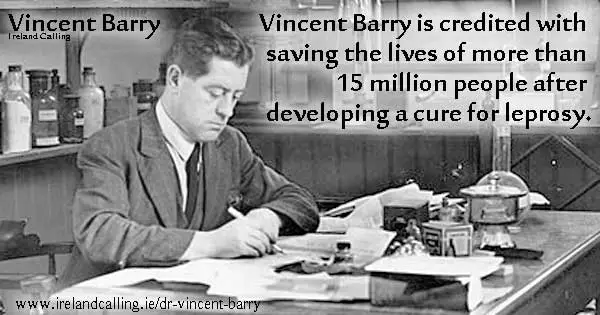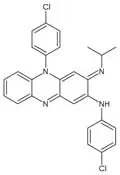Irish scientist Vincent Barry is credited with having saved the lives of more than 15 million people after developing a cure for leprosy.
Leprosy has plagued mankind for thousands of years and is only now being eradicated thanks to the work of Dr. Barry.
Barry was born in Cork in 1908. He was a bright child with a huge passion for science. He won a scholarship to University College Dublin where he gained a first class honours degree in organic chemistry.

After he left university, he worked at University College Galway for 10 years as assistant to Professor Thomas Dillon before moving to back to Dublin in 1943. He took a job with the Medical Research Council investigating chemotherapy of tuberculosis.
Leprosy – similar bacteria to TB
Tuberculosis was a common disease in the 1940s, but during Barry’s time at the Medical Research Council, it became more manageable.
It was then that Barry turned his attention to leprosy. He built on the work of Norwegian scientist, Gerhard Hansen. In the 1870s, Hansen had discovered that leprosy was caused by bacteria and was not hereditary as people had believed at the time.
Barry realised that although the symptoms are very different, the bacteria that causes leprosy is very similar to the bacteria that causes TB. He started to look at how his research on TB could be applied to leprosy.
Barry developed Clofazimine to fight leprosy
Barry travelled to India and Zimbabwe visiting leper colonies and speaking to leprosy officers at The Mission to Lepers, which was founded by fellow Irishman Wellesley Bailey back in the 1870s.
An estimated 15 million people owe him their lives.
He knew he was close to finding a cure and meeting these people fuelled his desire to help them.
Back in Dublin in a laboratory at Trinity College, he led a team of scientists who synthesised a compound called B663 (Clofazimine). Clofazimine would become part of a multi drug treatment (MDT) for leprosy sufferers.
Clofazimine introduced to MTD in 1981

In the early 1970s Stanley McElhinney, a County Donegal man and member of Dr Barry’s team, led the negotiations with the Indian Government to introduce clofazimine.
The World Health Organisation made clofazimine a mandatory part of the multi drug treatment of leprosy in 1981, six years after Barry’s death. The MDT also included dapsone and rifampicin. People suffering a severe form of leprosy would be completely cured after a two year course of the drug. People with a milder form would only need a six month course.
The team was not interested in fame or fortune, their goal was simply to make the drug available in the developing world. Ken Gibson, chief executive officer of The Leprosy Mission said “It was all very low key… this was an extraordinary, quiet revolution”
Leprosy close to being eradicated
Since the drug was introduced, leprosy cases across the world have plummeted and we can realistically expect the disease to be eradicated within the next 30 years.
Dr Barry’s daughter said he would have been so proud to have seen what he and his team had achieved. She said “He was very interested in helping people and he was very patriotic. The fact that Ireland was doing something to help leprosy was very important to him.”
In 2008, the Leprosy Mission held an event at Dublin’s Royal Irish Academy in honour of the 100th anniversary of Dr. Barry’s birth.
He was popular in Dublin and a large crowd attended his funeral including Dr Cearbhall O Dalaigh (president), Mary Robinson (future president) and many ordinary people including his regular bus driver!
Dr Mairead Hannon , his daughter, said “My father always took the 47 bus into town and the driver knew all about him and his work and turned up to his funeral.”
